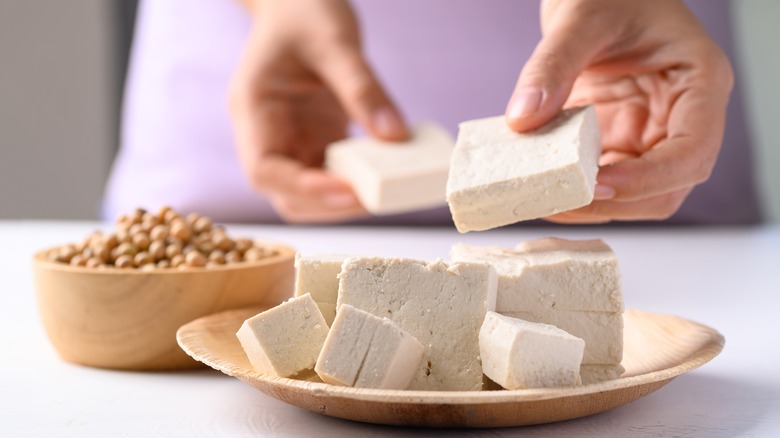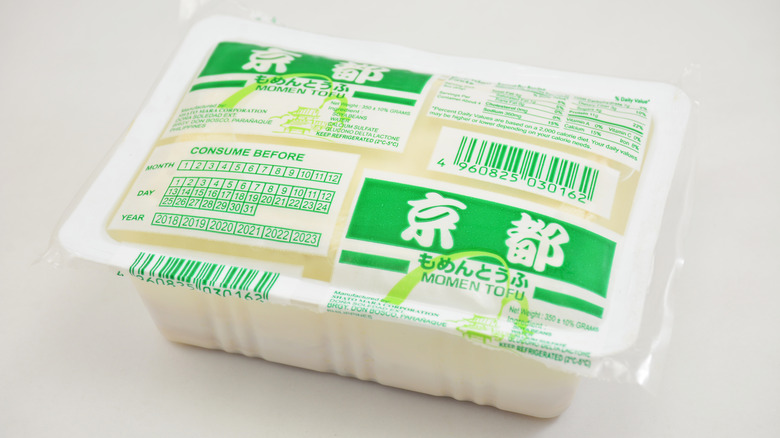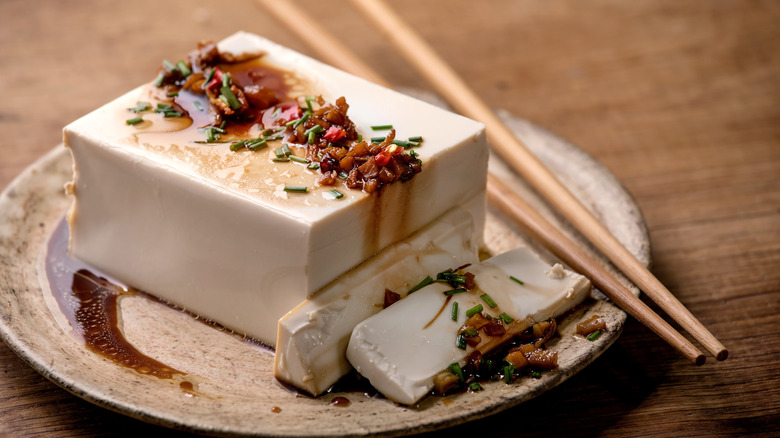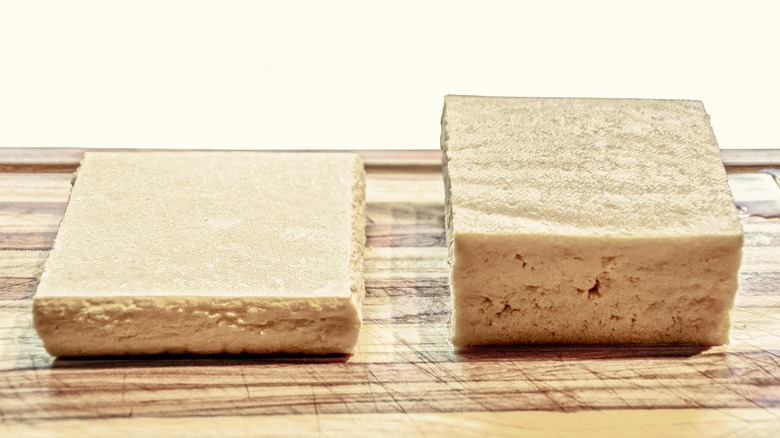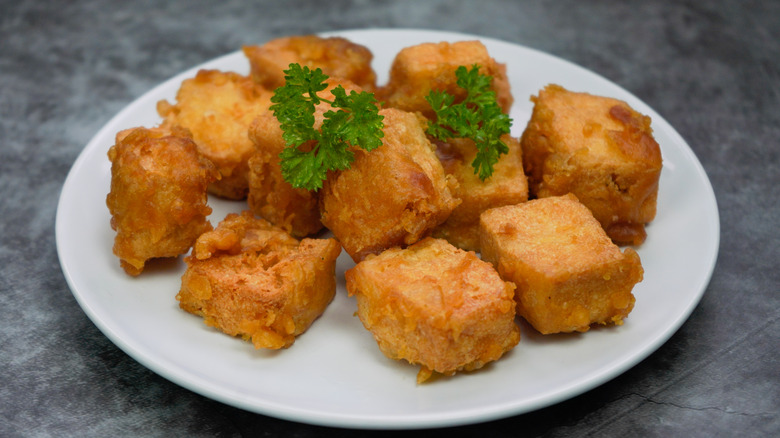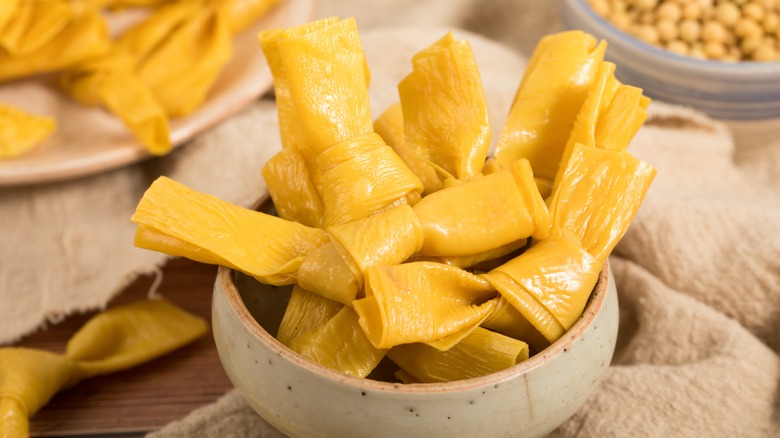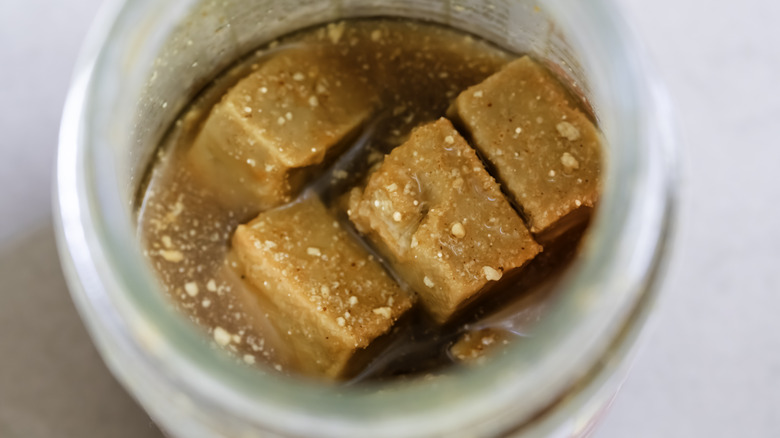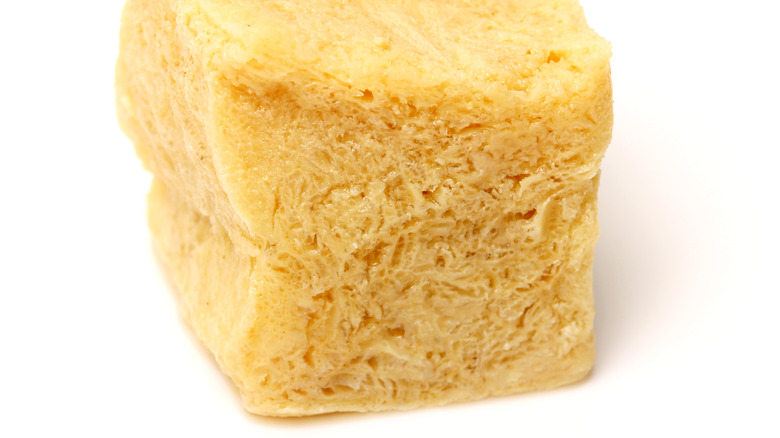10 Styles Of Tofu You Should Be Cooking Up
Invented around 2,000 years ago, tofu — also called bean curd — has been nourishing China and much of eastern Asia ever since. For much of its history, tofu was regarded as peasant food until the Qing Emperor Kung Xi (1662-1722) encountered it while mingling incognito among the commoners. So taken with it, the emperor insisted his chefs make it as well. That was, evidently, exactly the celebrity endorsement it needed.
Of course, tofu has plenty of good things going for it already. Made from soy, it has nearly twice the amount of protein as other legumes and is a terrific source of iron, calcium, magnesium, and assorted B vitamins. Being a plant protein, tofu is also significantly lower in saturated fats, making it a heart-healthy food.
Made from coagulated soy milk, tofu's blandness is what makes it so versatile. Tofu can be cooked in a multitude of ways, and readily picks up the flavors of other ingredients in the dish, meaning you have an ingredient that is as delicious as you care to make it. Tofu also comes in a wide variety of consistencies, with some versions more appropriate for certain dishes.
Having cooked with tofu for 16 years, via trial and error I've gathered a wealth of information on how to work with this food. I've also used information gleaned from well-known cooks such as Fuchsia Dunlop and Deh-Ta Hsiung to offer this definitive list on the various types of tofu and how you should cook with them.
1. Buying and storing tofu
All types of tofu are typically packed in water to keep it fresh — although some very soft varieties can be packed in clear plastic tubes — and it should be good for several days. If, after about five days or so, you still haven't had the chance to cook it up, transfer the tofu to another container and change out the water. It can also be frozen which opens up other possibilities. Tofu should smell fresh when you open its packaging and will have a vaguely beany scent. The water it's packed in isn't really useful once you've opened it, so that can be disposed of.
You can also buy it vacuum-packed in shelf-stable packaging, as well, and different companies sell it in different amounts, ranging from about 12 ounces to 1-pound blocks. If you're fortunate enough to live in a city where it's made fresh daily, that should be your go-to.
2. Soft and silken tofu
These varieties are quite delicate and require a little finesse when cooking with them. Soft tofu isn't subjected to pressing when it's made, which helps increase the tofu's density resulting in a firmer product. Instead, soft tofu is allowed to set naturally, with the result being a very soft, almost custard-like product particularly favored in Japanese cuisine. Consequently, it can fall apart quite easily if tossed around too enthusiastically in the pot. But, that can be part of its appeal, as it can lend a rustic look to simple soups and blends easily with other foods such as eggs.
Soft tofu is the star in the classic Chinese dish, Mapo Tofu, where it's paired with chewy, crispy minced pork in a complexly flavored chili sauce. The chewiness of the pork is a wonderful contrast to the smooth, braised pieces of tofu. In Japan, silken tofu is often served as a block, chilled, and topped with any number of ingredients, from pickled ginger and scallions to chilies and sesame oil, for a simple no-cook dish that's incredibly flavorful and refreshing. The silken tofu stands out, and the toppings accentuate its freshness.
3. Firm, extra firm, and doufu gan tofu
The varieties you're most likely to use day-to-day are firm and extra firm. Their density makes them incredibly versatile, as they'll generally hold up in everything from deep-fat frying to long simmers in soups and stews. These are also the varieties you're most likely to find in the average grocery store.
Pressed tofu — or doufu gan, meaning "dried bean curd" in Chinese — refers to a very dense form, pressed until almost all the water has been forced out, and often flavored with soy sauce and five-spice powder, a popular spice blend used in many Chinese dishes. It's also available smoked, giving it a much more complex flavor.
Doufu gan has a consistency not unlike a low-moisture cheese. Because of pressed tofu's extremely dense texture, it can be easily shredded, so it's often added to soups like that perennial restaurant favorite: hot and sour soup. With its savory flavor and meaty consistency, it's frequently used to simulate meat in vegetarian dishes. Minced, it makes its way into steamed dumplings and other snacks. It even shows up raw in cold dishes. Pressed tofu, like regular tofu, must be refrigerated but it has a long shelf life and kept properly wrapped, will last for several weeks.
4. Fried tofu
Frying tofu until it's golden and crispy not only adds flavor but also gives the tofu a meaty, chewy texture that soaks up flavors more readily than plain tofu. You can find fried tofu in Asian and Chinese markets where it is sold in bulk but, without access to those, you can fry it at home. In the stores, it will come in puffy cubes around 1-inch square. That's an ideal size for making at home, too, as it works well in stews and saucy dishes.
Place the tofu on a cooling rack set on a baking sheet to catch the water as it drains off. Cover it with a kitchen towel and then top it with an iron skillet. While you prep other ingredients let it sit for about an hour. You'll find that a great deal of water has been pressed out. Go ahead and cut the tofu into cubes, pat them dry, and you're ready to fry.
You'll need about a quart of neutral oil (peanut is best but use your favorite as long as it has a high smoke point), a good heavy, deep pot or wok, and a sheet tray or plate lined with paper towels for draining after they're fried. Fry the cubes in small batches until they are golden, and let them drain. Once you're done, they're ready to use in a stir-fry or mixed with grains like rice, quinoa, or barley, for example.
5. Tofu skin and sticks
Made from the skin that forms on soy milk, the resulting sheets are dried, and are often used as wrappings or are simply added to dishes. When you buy them, they'll come in roughly letter-paper-sized sheets, several to a bag. They'll need to be soaked in cold water first and, depending upon the brand you buy, that can take anywhere from about 15 minutes to an hour. Once they're supple enough to use, blanching them for about 15 seconds in boiling water helps freshen up their flavor.
Tofu skins are quite versatile and are included in everything from soups and stir-fried dishes to being used as wrappings for both fried and steamed foods. If you're a fan of egg and spring rolls, tofu skins make a great wrapping for either.
Tofu sticks are just tofu skins that have been rolled and bundled into sticks and dried. Unlike the plain skins, tofu sticks will require quite a bit of soaking before use — anywhere from a few to 24 hours depending upon their quality. Frequently found in stews and soups, it has a distinctive texture and has traditionally been used in Buddhist vegetarian recipes to help simulate the texture of meat. Tofu sticks are also available in a knotted form. Their use and flavor aren't any different from plain tofu sticks. They have a long shelf life and will live quite contentedly in your pantry for up to a year.
6. Fermented tofu
To say that fermented tofu has a distinctive flavor is like saying that pizza has a few calories. Cookbook author Fuchsia Dunlop describes it rather diplomatically as having "a strong fermented taste somewhat reminiscent of Roquefort.” That said, fermented tofu adds a terrific salty, savory depth to dishes and is well worth seeking out.
While it's available in several varieties, the two you're most likely to encounter are white and red. White is commonly used as a condiment where is preserved in a yellowish brine (from sorghum liquor), it is often made with chilies, giving it a satisfying heat and pungency. It's a favorite addition to simple dishes like jook — a warming rice porridge that's good for breakfast or after a night on the town. Red fermented tofu is almost purple, is made with red rice yeast and rice wine, and is a favorite addition to braised meats. It also makes a great addition to marinades for red meat.
Both types are cut into small cubes and must be kept refrigerated, in an air-tight jar where they'll keep for up 6 months. Another simple way to use it is to mix a cube of it in enough water to dissolve it, and then add that to simple vegetable stir-fry dishes, particularly greens. You won't use much of either type in any one dish; they're so strongly and distinctively flavored, you won't need to.
7. Frozen tofu
Freezing tofu changes its texture dramatically and opens up several interesting possibilities. You do, however, need to plan as it will take several hours for it to freeze solid. Once thawed, frozen tofu has a spongy, meaty texture that absorbs flavors like — well, that proverbial sponge — thanks to the zillions of little air pockets that develop inside the tofu while it freezes (whereas with regular, unfrozen tofu, the seasonings tend to coat just the outside). Remove your tofu from its container, drain it, and then wrap it in plastic wrap or a sealable container, place it on a flat surface in your freezer, and leave it there for the next five or six hours (or even overnight if that's easier).
When you're ready to use it, pull it out and wait for it to thaw. Then, press it again for 30 minutes or longer to get rid of any moisture left over from thawing. That's it. Just cook with it however you were planning to.
